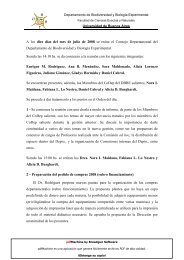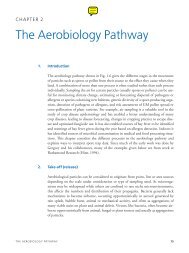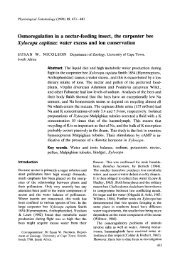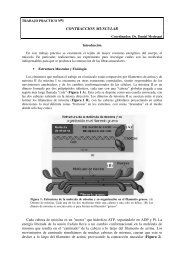Role of WUSCHEL in Regulating Stem Cell Fate in the Arabidopsis Shoot Meristem
Role of WUSCHEL in Regulating Stem Cell Fate in the Arabidopsis Shoot Meristem
Role of WUSCHEL in Regulating Stem Cell Fate in the Arabidopsis Shoot Meristem
You also want an ePaper? Increase the reach of your titles
YUMPU automatically turns print PDFs into web optimized ePapers that Google loves.
<strong>Cell</strong><br />
810<br />
Figure 4. Expression <strong>of</strong> WUS mRNA <strong>in</strong> <strong>Arabidopsis</strong><br />
Embryo Development<br />
(A) An 8-cell embryo. The four upper cells,<br />
two <strong>of</strong> which are seen <strong>in</strong> <strong>the</strong> plane <strong>of</strong> section,<br />
will give rise to cotyledons and shoot meristem,<br />
while <strong>the</strong> four lower cells will form hypocotyl<br />
and root. Tissue layers have not formed<br />
yet. WUS mRNA was not detected at or before<br />
this stage.<br />
(B) A 16-cell embryo. All cells <strong>of</strong> <strong>the</strong> eight-cell<br />
embryo shown <strong>in</strong> (A) have divided pericl<strong>in</strong>ally,<br />
separat<strong>in</strong>g <strong>the</strong> outer protoderm and <strong>the</strong> <strong>in</strong>ner<br />
cells. In <strong>the</strong> <strong>in</strong>ner cells <strong>of</strong> <strong>the</strong> apical region<br />
(white arrow), WUS mRNA is detected, but<br />
not <strong>in</strong> <strong>the</strong> basal region or <strong>in</strong> <strong>the</strong> protoderm<br />
(black arrow).<br />
(C) One <strong>of</strong> <strong>the</strong> <strong>in</strong>ner apical cells shown <strong>in</strong> (B)<br />
has divided longitud<strong>in</strong>ally. The daughter cell<br />
<strong>in</strong> <strong>the</strong> center (white arrow) cont<strong>in</strong>ues WUS<br />
expression, whereas <strong>the</strong> peripheral daughter<br />
has discont<strong>in</strong>ued WUS expression (black<br />
arrow).<br />
(D) A 32-cell embryo. All <strong>in</strong>ner apical cells<br />
shown <strong>in</strong> (B) have divided longitud<strong>in</strong>ally. WUS<br />
mRNA is detected <strong>in</strong> <strong>the</strong> central daughter<br />
cells (white arrow), but not <strong>in</strong> <strong>the</strong> peripheral<br />
daughters (black arrow).<br />
(E) Transition-stage embryo. The apical doma<strong>in</strong><br />
conta<strong>in</strong>s two cell layers, <strong>the</strong> protoderm<br />
and one subepidermal layer. Two subepidermal<br />
cells <strong>in</strong> <strong>the</strong> center express WUS (white<br />
arrow).<br />
(F) Heart-stage embryo. The subepidermal<br />
cells shown <strong>in</strong> (E) have divided transversely,<br />
result<strong>in</strong>g <strong>in</strong> a three-layered apical doma<strong>in</strong>.<br />
WUS mRNA was detected <strong>in</strong> <strong>the</strong> lower daughters<br />
but not <strong>in</strong> <strong>the</strong> upper daughters <strong>of</strong> <strong>the</strong><br />
WUS express<strong>in</strong>g cells shown <strong>in</strong> (E). The black<br />
l<strong>in</strong>e represents <strong>the</strong> plane <strong>of</strong> <strong>the</strong> section shown<br />
<strong>in</strong> (G).<br />
(G) Heart-stage embryo. Only a s<strong>in</strong>gle cell expresses<br />
WUS <strong>in</strong> a longitud<strong>in</strong>al section as <strong>in</strong>dicated<br />
<strong>in</strong> (F).<br />
(H) Late-stage embryo. A small cell group <strong>of</strong><br />
<strong>the</strong> shoot meristem expresses WUS. The outer<br />
two layers do not show WUS expression.<br />
(I) Late heart-stage embryo. Sense control.<br />
No sta<strong>in</strong><strong>in</strong>g detected.<br />
(K) Late-stage stm embryo. WUS expression<br />
is found <strong>in</strong> cells underneath <strong>the</strong> po<strong>in</strong>t where<br />
<strong>the</strong> cotyledons meet (arrow).<br />
(L) Late-stage wild-type embryo. STM is expressed<br />
throughout <strong>the</strong> shoot meristem bulge.<br />
(M) Late-stage wus embryo. STM is expressed<br />
<strong>in</strong> a few apical cells.<br />
WUS mRNA is <strong>in</strong>dicated by dark brown.<br />
*, cells <strong>of</strong> <strong>the</strong> <strong>in</strong>tegument show dark brown<br />
color <strong>in</strong>dependently <strong>of</strong> <strong>the</strong> <strong>in</strong> situ hybridization.<br />
c, cotyledon; v, vasculature; p, leaf primordium;<br />
sus, suspensor. Scale bars, 10 �m.<br />
WUS Represents a Novel Type phenotypic defects (Laux et al., 1996). The less severe<br />
<strong>of</strong> Homeodoma<strong>in</strong> Prote<strong>in</strong>s<br />
wus-3 phenotype results from an am<strong>in</strong>o acid exchange<br />
Our data <strong>in</strong>dicate that WUS represents a novel subtype <strong>in</strong> <strong>the</strong> N-term<strong>in</strong>al part <strong>of</strong> <strong>the</strong> homeodoma<strong>in</strong>. The analysis<br />
<strong>of</strong> homeodoma<strong>in</strong> prote<strong>in</strong>s and functions as a transcrip- <strong>of</strong> mutant homeodoma<strong>in</strong>s has suggested that this region<br />
tional regulator. The early nonsense mutation <strong>in</strong> wus-4 is essential for DNA b<strong>in</strong>d<strong>in</strong>g specificity (Laughon, 1991;<br />
<strong>in</strong>dicates a complete loss <strong>of</strong> function <strong>in</strong> this allele. From Kornberg, 1993). The phenotypic defects <strong>in</strong> <strong>the</strong> wus-3<br />
<strong>the</strong>ir <strong>in</strong>dist<strong>in</strong>guishable phenotypes compared to wus-4, mutant may thus result from a reduced aff<strong>in</strong>ity <strong>of</strong> WUS<br />
we conclude that wus-1 and wus-2 also represent null for its DNA target(s), consistent with its proposed func-<br />
alleles, support<strong>in</strong>g <strong>the</strong> previous <strong>in</strong>terpretation <strong>of</strong> <strong>the</strong>ir tion as a transcription factor.


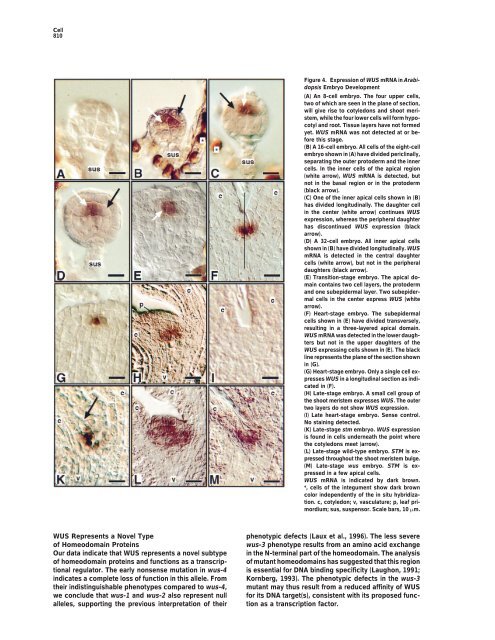
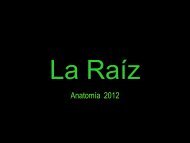
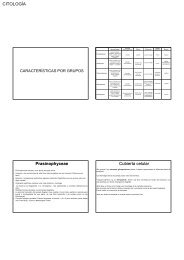


![Estructuras secretoras internas [4.64 MB]](https://img.yumpu.com/14294979/1/190x143/estructuras-secretoras-internas-464-mb.jpg?quality=85)
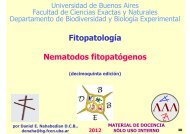
![anatomía y exomorfología [7.14 MB]](https://img.yumpu.com/12744163/1/190x143/anatomia-y-exomorfologia-714-mb.jpg?quality=85)
